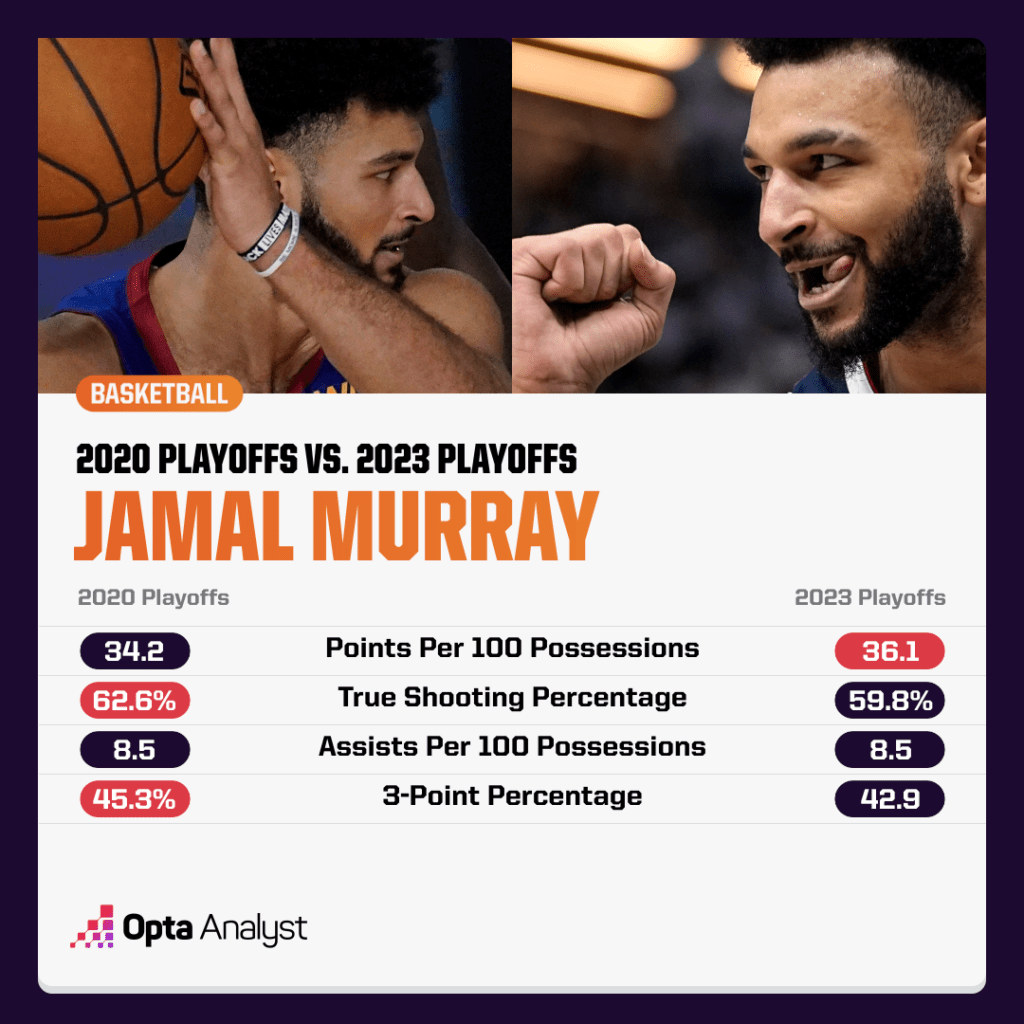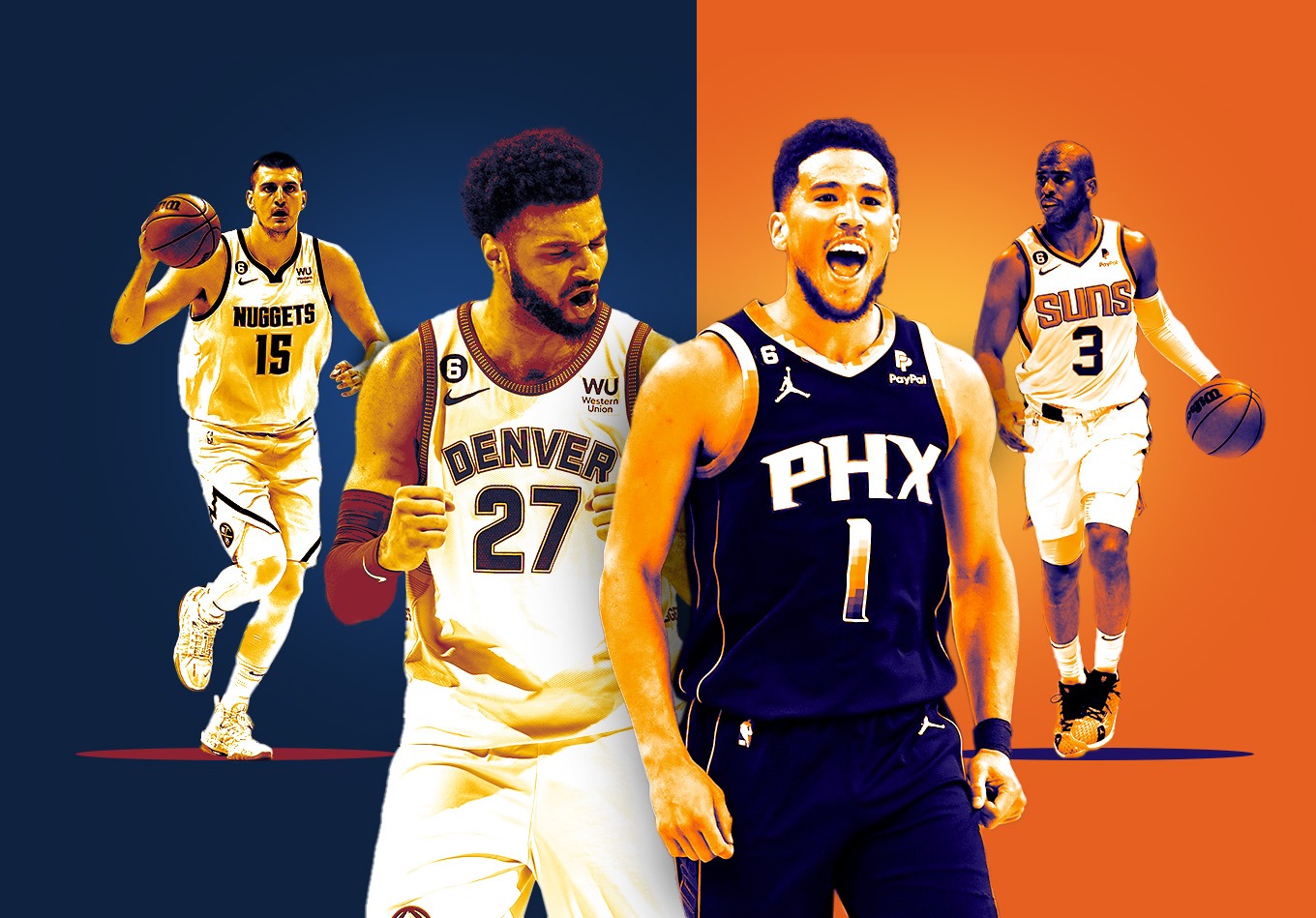Since the moment that it was announced that the Phoenix Suns had acquired Kevin Durant to tipoff what will forever go down as a historic trade deadline day, a matchup between them and the conference-leading Denver Nuggets in the NBA playoffs has seemed almost preordained.
And while this heavyweight fight against arguably the two best teams in the conference may be coming one round sooner than we’d hoped, it is nonetheless a heavily anticipated battle.
To prime you for this earth-shaking showdown, here are five storylines to keep an eye on heading into the Western Conference semifinals.
(Sidebar: Stick around until the very end to see what our playoff projection model thinks of this series!)
1. How Does Denver Defend Phoenix?
In their first-round series against the Minnesota Timberwolves, the Nuggets typically played ball screens featuring Nikola Jokic as the defending big man in a drop or at the level of the screen.
The former will largely be a no-go in this series, as drop coverage’s most exploitable weakness is that – unless you have great screen navigating perimeter defenders – it provides a runaway for pull-up jumpers. With the Suns rostering the likes of Durant, Devin Booker and Chris Paul, it seems obvious that this would not be a good idea.
To avoid getting torched by these pull-up assassins, Denver will likely play many screens at the level. This effectively takes away the red carpet that drop coverage rolls out. But it comes with the tradeoff of conceding an automatic 4-on-3 advantage to the offense (because you are effectively putting two defenders on the ball).
Among other things, one wrinkle the new-look Suns discovered against the Los Angeles Clippers was how to station Durant/Booker on the weak-side corner (the place where defensive help usually comes from) to burn teams when they’d put two defenders on the ball handler.
How will Denver navigate this spacing alignment? Will the Nuggets send help from elsewhere?
Do they turn to a different defensive coverage?
2. The Joker Stopper
We recently went in-depth on Deandre Ayton’s importance to the series. Well, in the 2021 second-round series (the last time these two teams had it out), Ayton made a name for himself as a Nikola Jokić stopper after he held the Joker to 27-of-64 shooting (42.2%) and just three free-throw attempts in their encounters during the four-game series (per NBA.com).
Will a similar story play out in their playoff rematch?
Probably not. When these guys brawled in 2021, Jokic was flanked by a motley crew supporting cast. At the time, Denver was without Jamal Murray (who had been lost for the year with a torn ACL) and had still yet to acquire staple contributors like Bruce Brown, Kentavious Caldwell-Pope, Jeff Green and Christian Braun.
Simply put, Jokić’s bandmates look more like The Beatles now rather than the group of high school misfits they were in 2021. This means that the Suns can no longer allocate extra resources toward assisting Ayton in defending the two-time MVP, who averaged nearly a triple-double with 26.2 points, 12.4 rebounds, 9.0 assists and 1.2 steals in the first round.
Ayton will be left largely to his own devices in this playoff series. He doesn’t need to put together a repeat performance of 2021, but can he slow Jokić enough to get them across the finish line?
3. The Return of Bubble Jamal Murray
Don’t look now, but Jamal Murray is hooping. After spending most of the regular season getting back into form, Murray started to look more like the guy who stole the show in the 2020 Orlando Bubble during Denver’s first-round series against Minnesota.
Here’s a look at how his stats in that five-game series compare to his illustrious 2020 playoffs:

His volume scoring and playmaking numbers are at or above the levels from his Bubble run, and his efficiency isn’t lagging too far behind, either. This is especially important to keep tabs on moving forward because, along with taking relief off of Jokić’s shoulders and bringing out the best in Michael Porter Jr., Murray’s offensive performances tend to have an eruptive quality.
Basically, he’s the kind of player that can get so hot that he can swing an entire game or two in a series on his lonesome. With how evenly matched these teams seem to be on paper, if Murray’s out here winning games on his own it might just be enough to push Denver past Phoenix in this series.
(Sidebar: Murray has been playing some of the best defense of his life so far in this postseason!)
4. A Battle of Bodies
One of the biggest question marks about the Nuggets heading into the postseason was regarding their depth. That makes this next statement pretty wild. The Nuggets, who are the last No. 1 seed standing after the Milwaukee Bucks bowed out, actually have the depth advantage (at least on paper) in this series.
Against the Timberwolves, Denver almost exclusively relied on an eight-man rotation consisting of its starting five, Brown, Braun and old man Jeff Green.
Does Phoenix have eight guys it can rely on? Do the Suns even have five? Even against the injury-riddle Clippers, coach Monty Williams was forced to ride his starters hard. Kevin Durant played 43.8 minutes per game, Booker 43.2, Paul 38.5 and Ayton 34.3.
Plus, outside of those four, the only other player who averaged more than 7.0 points in the series was Torrey Craig (12.5), who feasted on a diet of mainly wide-open shots that Los Angeles was willing to concede to him in order to focus in on the Suns’ core four.
The Suns have players who could potentially contribute big minutes for them in this series. We mentioned Craig, but they also have guys like Josh Okogie, Damion Lee (my personal favorite), Ish Wainwright, T.J. Warren, Cameron Payne, Terrence Ross and Landry Shamet on the bench.
If the Suns could get just two or three of those guys to pop in this series, it would be huge. But can they get even that?
5. Bringing a Calculator to the Dance
Of all the playoff teams, the Suns have taken the second-lowest percentage of its shots between 0-3 feet (24.7%) and the lowest percentage from behind the 3-point line (27.5%). What’s more, the Suns take the highest percentage of shots between 10-16 feet (26.6%), and from 16 feet to the 3-point line (15.0%) of any postseason team.
The Suns take a lot of midrange jumpers. And while that shot isn’t as problematic as some people make it out to be, it does present a bit of a math problem for them in this series.
Think of it this way, the average conversion rate among playoff teams on shots between 0-3 feet from the rim is 68.3%. That’s roughly 1.37 points per possession. The playoff average on 3s is 35.6% – roughly 1.07 points per possession. Inversely, the playoff average on shots between 10-16 feet is 44.8% (0.90 points per possession), and the playoff average on shots between 16-22 feet is 43% (0.86 points per possession). Do you see the problem here?
Now, if anyone has the midrange shooters necessary to throw the math out the window, it’s the Suns. For instance, in the first round, they shot 55.4% (the highest of any team) from 16 feet to the 3-point line. That’s about 1.10 points per possession, which is slightly above the efficiency of the average playoff 3 this year.
But the question is can they sustain this? What happens if their midrange game isn’t hitting the way it was in the first round? Will they look to revise their shot diet? Do they even have the means to do so?
Who Has the Edge?
In terms of the moneyline, sportsbooks have the Suns as the NBA betting favorites (-127) and the Nuggets as the underdogs (+105) despite holding home-court advantage at Ball Arena. But what is our model’s prediction for who will advance to the conference finals?
This model calculates each team’s chances of making it to the semifinals, conference finals, NBA Finals and winning the title outright, based on 5,000 simulations of the playoffs.
It incorporates our adjusted team ratings (including overall adjusted team rating, adjusted offensive rating and adjusted defensive rating), accounts for recency bias (so, it gives more weight to teams that enter the second round playing well rather than those who stumbled through the first round) and for how well teams performed against other good teams (because in the playoffs you typically have to beat them).
Here are the model’s projections in real time. These will updated throughout the series:
Probabilities of Advancing to Each Round of the NBA Playoffs
Don’t forget to follow us on Twitter.
